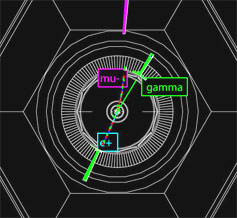

Tuesday - November 27, 2007
SLAC Today is available online at:
http://today.slac.stanford.edu
In this issue:
A Particle of a Different Flavor?
Safety Today: Traffic at the Main Gate
SLAC Shows at SC 07
 |
 |
|
Tuesday - November 27, 2007 |

A simulated tau/anti-tau event in the BaBar detector. (Image courtesy of Swagato Banerjee.)
A Particle of a Different Flavor?Just as chocolate ice cream never spontaneously becomes strawberry or vanilla, leptons—electrons, muons and taus—are supposed to conserve their "flavor," or family. That is, taus can decay into tau neutrinos, but not electron or muon neutrinos, and when a decay produces one kind of lepton, a matching anti-neutrino should come with it. Researchers at SLAC are currently searching for evidence that one lepton breaks these rules. If they succeed, it would pave the way for new physics. The rules come from the Standard Model of particle physics—but many physicists believe that the Standard Model isn't complete. According to Soeren Prell, current BaBar physics analysis coordinator and a professor at Iowa State University, almost every particle physics measurement is checked against the Standard Model and generally the theory holds up remarkably well. However, the theory can't explain everything, and several new extensions are waiting in the wings. The search for lepton-flavor-violating processes is one of many efforts to discover violations of the Standard Model. BaBar's primary objective is to study B mesons, produced by the collision of electrons and positrons. But, in addition, such collisions produce large numbers of tau and anti-tau particles. Members of the BaBar tau analysis working group, led by Swagato Banerjee and Alberto Lusiani, are combing through Babar's copious data to search for lepton flavor violation. Read more... |
||
|
|
||

Traffic at the Main GateThe traffic regulations in place at the Main Gate are intended to allow for the smooth flow of traffic into and out of the SLAC site. Please be careful as you make your way though the Main Gate and be sure to follow the posted regulations.
Main Entry
Westbound Traffic
Eastbound Traffic If you have any questions about driving policies at the lab, please contact SLAC Security Manager Simon Ovrahim at x2310. |
SLAC Shows at SC 07
Earlier this month, 14 SLACers joined 300 exhibitors, more than 9,000 attendees, over a billion dollars in equipment and much of the world's newest and fastest information technologies at Supercomputing 2007. Held in Reno, Nevada, the event offered a busy schedule of sessions, workshops, challenges, demonstrations and speakers. In addition, a massive exhibition floor brought together all the top contenders in high performance computing—including SLAC and Stanford University. This year, the SLAC computing team partnered with several groups from Stanford University to set up a 5x5 monitor display floor. Conference attendees were invited to literally step into Stanford research by walking over the horizontal screens, which featured animations prepared by researchers in SLAC's Advanced Computations Department (ACD), BaBar, the Kavli Institute for Particle Astrophysics and Cosmology (KIPAC), LCLS Ultrafast Science Instruments (LUSI), Stanford University Medical Media and Information Technology (SUMMIT), Physics-based Simulation of Biological Structures (Simbios), the Stanford Cardiovascular Biomechanics Lab, the Center for Computational Earth and Environmental Science (CEES) and Folding@home. In addition, the display included a cloud chamber, a cosmic ray detector, a klystron, a virtual surgery demonstration, the first Google IT storage system and a PlayStation 3 demonstrating Folding@home—a program that recently was named the world's most powerful distributed computing network by the Guinness Book of World Records. "The event went extremely well," said Project Leader Alf Wachsmann of SLAC's Scientific Computing and Computing Services Group. "Many thanks to those who made this display possible, everyone from the Klystron Department to the Mechanical Fabrication Department's Welding and Carpentry shops." See a photo of the SLAC and Stanford presenters here. |
Events (see all | submit)
Access (see all)
Announcements
|
| | ||
|
|
||
 <%
Response.AddHeader "Last-modified", getArticleDate()
'Response.AddHeader "Last-modified","Mon, 01 Sep 1997 01:03:33 GMT"
'Monday, December 06, 2010
%>
<%
Response.AddHeader "Last-modified", getArticleDate()
'Response.AddHeader "Last-modified","Mon, 01 Sep 1997 01:03:33 GMT"
'Monday, December 06, 2010
%>View online at http://today.slac.stanford.edu/ |
||